- Joined
- Jun 26, 2020
- Messages
- 164
I have a knife with sandwich of elmax and stainless damascus , I was advised to etch with citric acid , what is the best mix of citric acid and what time should I put it in , basically this is an I want to skip the experimenting and do the workpiece straight up kind of question








